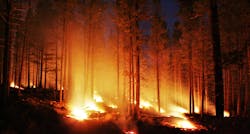ATC and Hiawatha National Forest Develop Operating Plan Agreement
The Hiawatha National Forest and American Transmission Co. have developed a first-of-its-kind operating plan between a utility and national forest since the United States Department of Agriculture (U.S.D.A) Forest Service adopted a new rule to prevent power lines from sparking wildfires on public land. The plan will protect public lands and improve the safety and reliability of the transmission system while also providing significant long-term cost savings for the public, the company, and the agency. ATC’s cost savings will ultimately be passed down to electric consumers through their local utility.
“The Forest Service has a responsibility to protect and care for Hiawatha National Forest. We also understand how critical electricity is for people in the Upper Peninsula,” said Emily Platt, Acting Hiawatha Forest Supervisor. “That’s why creating an efficient, effective operating plan was so important. We appreciate that ATC cared as much about helping to protect the forest as they do about maintaining a safe and reliable electric grid.”
Across the nation, the U.S.D.A. Forest Service works with utility companies to manage permits for corridors crossing public lands–a significant duty for the agency and the utility companies. ATC operates approximately 95 miles of electric transmission line corridor within the Hiawatha National Forest’s 895,000 acres (about the size of Rhode Island). The new operating plan enables the Hiawatha and ATC to uphold environmental responsibilities more efficiently and effectively, while further reducing the risk of wildfires.
Updating the existing operating plan required an environmental assessment as a part of the National Environmental Policy Act (NEPA). The assessment was reviewed by several interagency partners, including the U.S. Environmental Protection Agency, the U.S. Fish and Wildlife Service, and others.
Clear Expectations Save Time, Add Predictability
The new operating plan establishes clear expectations and coordination procedures for the next 30 years, defining the construction, maintenance and vegetation management activities ATC may perform; providing guidance and clarity for activities performed in sensitive areas and establishing a new communication framework between ATC and the Hiawatha.
“The Hiawatha National Forest staff has the enormous responsibility of managing nearly one million acres of protected forest and is understandably cautious about any work conducted within it,” said Jared Winters, director of ATC asset maintenance and commissioning. “At the same time, ATC has a duty and responsibility to ensure safe and reliable electric service to the homes and businesses that count on it every day.”
A critical component of the innovative operating plan is a time-saving geographic information system (GIS)-based communication process. The detailed GIS structure:
- Guarantees the exchange of key information relevant to all of ATC’s annual work in the Hiawatha utility corridor, simplifying implementation of most routine maintenance.
- Identifies sensitive areas within the utility corridor; the company will establish operations and maintenance design criteria, with the agency assuming a post-hoc review role. Under this new structure, ATC will prepare a year-end report so that the effectiveness of design criteria can be reviewed and refined on an ongoing basis.
- Establishes clear reporting and response dates, which help ensure electricity is delivered to customers safely and reliably.
Together, the components of the operating plan protect natural resources while simplifying interactions and eliminating unnecessary maintenance delays.
“We hope to use this streamlined operating framework as a model for other utility permits we manage here on the Hiawatha,” said Platt.
A New Solution Drives Cooperation
Dense vegetation, rough terrain, protected species restrictions and a lack of accessibility are just some of the challenges in maintaining the rights-of-way in the Forest. In 2019, ATC approached the Forest Service with another solution–one that hadn’t been used in the Hiawatha before–using an aerial power saw suspended from a helicopter to side trim vegetation. Discussions about the use of aerial saws contributed to the cooperative approach between ATC and Forest staff to update the operating plan.
Wide Transmission Corridors Reduce Fire Risk
Vegetation that grows too close to high-voltage transmission wires can cause a dangerous situation. Electricity can arc from the wires to a tree branch, igniting a fire or causing an outage. Dense, incompatible vegetation in the transmission line rights-of-way also can hinder access for crews and equipment needed to inspect, maintain, and make repairs to the poles and wires.
While the Hiawatha is not the most fire-prone of the 155 Forest Service units, it is still susceptible to fire. The new operating plan gives ATC the ability to clear rights-of-way to a width of 120 ft. ATC also will follow the same brush disposal methods that the Forest does, which help further reduce fire risk.
An added benefit of clearing the transmission corridors is that it promotes the growth of native grasses, low-growing shrubs and other native ground cover that bees, birds, butterflies, deer, and small animals prefer. Roughly 40% of the 10,000 miles of rights-of-way ATC manages has already been identified as suitable pollinator habitat.
Hiawatha National Forest is one of three National Forests within ATC’s service territory; others include the 1.5 million-acre Chequamegon-Nicolet National Forest in northern Wisconsin and the 990,000-acre Ottawa National Forest in the western section of Michigan’s Upper Peninsula.
